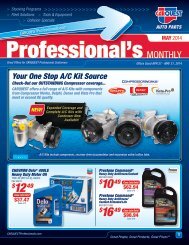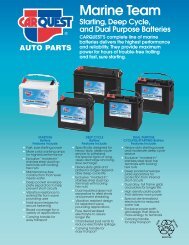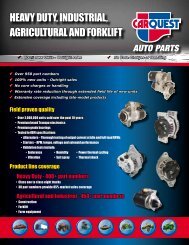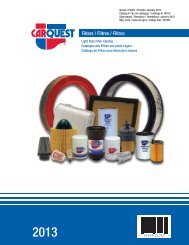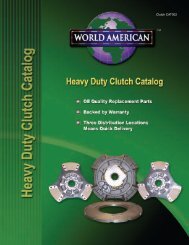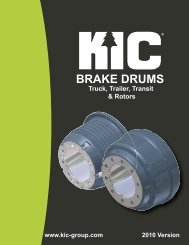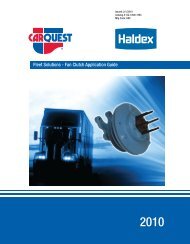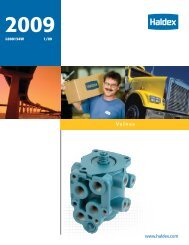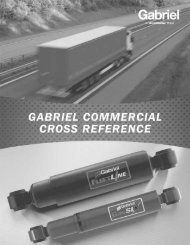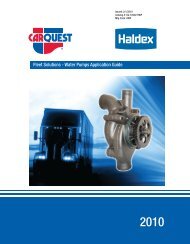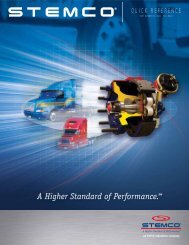Steering Gears Application Guide - CARQUEST Auto Parts
Steering Gears Application Guide - CARQUEST Auto Parts
Steering Gears Application Guide - CARQUEST Auto Parts
- No tags were found...
Create successful ePaper yourself
Turn your PDF publications into a flip-book with our unique Google optimized e-Paper software.
Sheppard Troubleshooting <strong>Guide</strong> 16−POWER STEERING GEARSSYMPTOM POSSIBLE CAUSE REMEDY<strong>Steering</strong> input not smooth (seizing,binding)Worn universal jointLack of lubricationUniversal joint not phased properlyLow oil flowPump cavitatingOverheatingCheck and replace as requiredLubricate per vehicle manufacturer'srecommendationsSee NOTE: Universal Joints belowIdle speed too slowDrive belts slippingSupply pump not to specifications (See"Hydraulic Supply−Diagnosis" proceduresCorrect pump supplyCorrect cause of overheatingDarting, wandering(oversteering)Oil flow too highAir trapped in steering gearLooseness, worn front end partsFront end alignment not correctRadial tire sidewall flexExcessive wear or damage in steering gearOverloading<strong>Steering</strong> column universal joint phasingincorrectMechanical bind in steering gearTight tie rod ends & drag link socketsSupply pump not to specifications (See"Hydraulic Supply−Diagnosis" Procedures)Bleed system (See Final AdjustmentsSection)Check and repair as requiredAlign front end CasterCheck tire pressureCheck for out of line treadContact tire manufacturer representativeCheck and repair as requiredReduce loadsSee NOTE: Unviersal Joints belowCheck steering gear mounting for distortionCheck for damaged or distorted steeringgear componentsCheck rotational torque & replace ifnecessaryExcessive backlashWorn universal jointWorn pins and keys universal joint toactuating shaft and universal tosteering shaftLow oil volumePitman arm ball worn "egg−shaped"Improperly adjusted drag link, pitman arm todrag link and steering arm to drag linkLoose bracket frame to bracket or bracketto gear bracketReplace universal jointReplace pins and keysCheck flow divider and pump driveReplace pitman arm assembly where rivetedball is used or only where bolted ballis used (vertical socket)Adjust drag link, drag link to pitman armand drag link to steering armRemove bracket, clean frame and bracketCheck radius of frame making sure is notbearing on radius surfaceCheck bracket for wear from workingReplace bracket and tighten to recommendedtorque rating according to size and gradeof boltsIf necessary, replace bracket with new oneNOTE: Universal JointsUniversal joints are designed to operate best when the angle between the drive and driven shafts is a maximum of 20 to 25 degrees. Angles greaterthan this will cause undesirable velocity changes between the two shafts. this velocity change may upset steering performance. When two universaljoints are used, it is in most instances possible to phase the two joints to match a high and low velocity in a manner that will provide equal velocitybetween the drive and driven shafts. A third universal joint in the shaft arrangement can upset the phasing of the first two joints and it is importantthat this third joints operating angle is limited to a maximum of 20−25 degrees.Phasing of the universal joints in the steering column can be checked quite easily. Using an inch−pound graduated dial reading type torque wrench,read the variation in the torque reading while steering from lock−to−lock, with a socket on the steering shaft nut under the horn button. Variation ofmore than 15 in.−lb. indicates improper phasing. This reading is taken with the vehicle stationary and the engine running.Phasing can usually be accomplished by rotating the two piece intermediate shaft one spline at a time until the torque reading remains the same allthe way around the 360 degree rotation of the steering wheel.16 − 33



